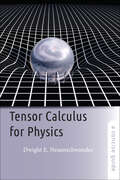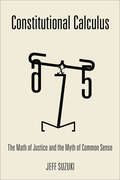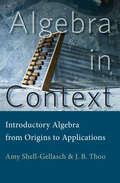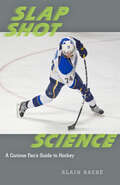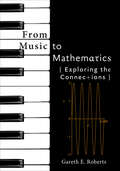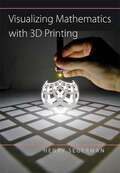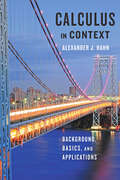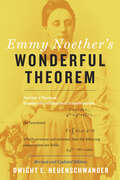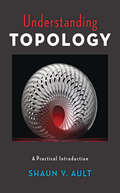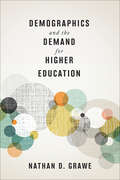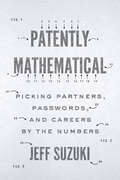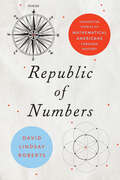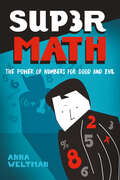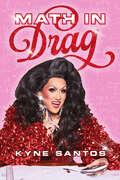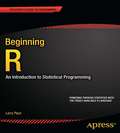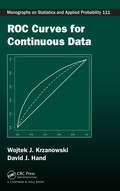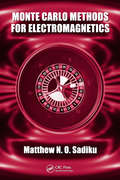- Table View
- List View
Tensor Calculus for Physics: A Concise Guide
by Dwight E. NeuenschwanderUnderstanding tensors is essential for any physics student dealing with phenomena where causes and effects have different directions. A horizontal electric field producing vertical polarization in dielectrics; an unbalanced car wheel wobbling in the vertical plane while spinning about a horizontal axis; an electrostatic field on Earth observed to be a magnetic field by orbiting astronauts�these are some situations where physicists employ tensors. But the true beauty of tensors lies in this fact: When coordinates are transformed from one system to another, tensors change according to the same rules as the coordinates. Tensors, therefore, allow for the convenience of coordinates while also transcending them. This makes tensors the gold standard for expressing physical relationships in physics and geometry. Undergraduate physics majors are typically introduced to tensors in special-case applications. For example, in a classical mechanics course, they meet the "inertia tensor," and in electricity and magnetism, they encounter the "polarization tensor." However, this piecemeal approach can set students up for misconceptions when they have to learn about tensors in more advanced physics and mathematics studies (e.g., while enrolled in a graduate-level general relativity course or when studying non-Euclidean geometries in a higher mathematics class). Dwight E. Neuenschwander's Tensor Calculus for Physics is a bottom-up approach that emphasizes motivations before providing definitions. Using a clear, step-by-step approach, the book strives to embed the logic of tensors in contexts that demonstrate why that logic is worth pursuing. It is an ideal companion for courses such as mathematical methods of physics, classical mechanics, electricity and magnetism, and relativity.
Constitutional Calculus: The Math of Justice and the Myth of Common Sense
by Jeff SuzukiHow should we count the population of the United States? What would happen if we replaced the electoral college with a direct popular vote? What are the consequences of allowing unlimited partisan gerrymandering of congressional districts? Can six-person juries yield verdicts consistent with the needs of justice? Is it racist to stop and frisk minorities at a higher rate than non-minorities? These and other questions have long been the subject of legal and political debate and are routinely decided by lawyers, politicians, judges, and voters, mostly through an appeal to common sense and tradition.But mathematician Jeff Suzuki asserts that common sense is not so common, and traditions developed long ago in what was a mostly rural, mostly agricultural, mostly isolated nation of three million might not apply to a mostly urban, mostly industrial, mostly global nation of three hundred million. In Constitutional Calculus, Suzuki guides us through the U.S. Constitution and American history to show how mathematics reveals our flaws, finds the answers we need, and moves us closer to our ideals. From the first presidential veto to the debate over mandatory drug testing, the National Security Agency's surveillance program, and the fate of death row inmates, Suzuki draws us into real-world debates and then reveals how math offers a superior compass for decision-making. Relying on iconic cases, including the convictions of the Scottsboro boys, League of United Latin American Citizens v. Perry, and Floyd v. City of New York, Suzuki shows that more math can lead to better justice, greater fairness, and a more stable democracy. Whether you are fascinated by history, math, social justice, or government, your interest will be piqued and satisfied by the convincing case Suzuki makes.
Algebra in Context: Introductory Algebra from Origins to Applications
by Amy Shell-Gellasch John ThooThis book’s unique approach to the teaching of mathematics lies in its use of history to provide a framework for understanding algebra and related fields. With Algebra in Context, students will soon discover why mathematics is such a crucial part not only of civilization but also of everyday life. Even those who have avoided mathematics for years will find the historical stories both inviting and gripping.The book’s lessons begin with the creation and spread of number systems, from the mathematical development of early civilizations in Babylonia, Greece, China, Rome, Egypt, and Central America to the advancement of mathematics over time and the roles of famous figures such as Descartes and Leonardo of Pisa (Fibonacci). Before long, it becomes clear that the simple origins of algebra evolved into modern problem solving. Along the way, the language of mathematics becomes familiar, and students are gradually introduced to more challenging problems. Paced perfectly, Amy Shell-Gellasch and J. B. Thoo’s chapters ease students from topic to topic until they reach the twenty-first century. By the end of Algebra in Context, students using this textbook will be comfortable with most algebra concepts, including • Different number bases • Algebraic notation • Methods of arithmetic calculation • Real numbers • Complex numbers • Divisors • Prime factorization • Variation • Factoring • Solving linear equations • False position • Solving quadratic equations • Solving cubic equations • nth roots • Set theory • One-to-one correspondence • Infinite sets • Figurate numbers • Logarithms • Exponential growth • Interest calculations
Slap Shot Science: A Curious Fan's Guide to Hockey
by Alain HachéFrom the moment the first player steps onto the ice, every conceivable principle of science is in play. To understand hockeyâ€�fully understand itâ€�Alain Haché argues that you must first learn how ice reacts to a passing blade, how the trajectory and aerodynamics of the puck affect its chances of getting into the net, how the tension on the stick transfers energy to the puck, and dozens of other details of the game.Slap Shot Science is an under-the-hood, behind-the-scenes, action-packed romp through special moments in the game as seen from the perspective of science and explained in a way everyone can understand. Among the topics Haché discusses are the differences between real ice and synthetic ice, the perfect amount of sharpness for a skate, how goalies can make spectacular saves even though the puck is traveling 100 miles per hour, whether players are skating faster today than in years past, and how equipment prevents many serious injuries. Slap Shot Science shows us how statistics can predict future performance by players and teams and why they can also be misused in many ways. By the close of the book you’ll see hockey in a more sophisticated and scientific light, and the reasons things happen the way they do will be clearer than ever.
From Music to Mathematics: Exploring the Connections
by Gareth E. RobertsTaking a "music first" approach, Gareth E. Roberts's From Music to Mathematics will inspire students to learn important, interesting, and at times advanced mathematics. Ranging from a discussion of the geometric sequences and series found in the rhythmic structure of music to the phase-shifting techniques of composer Steve Reich, the musical concepts and examples in the book motivate a deeper study of mathematics.Comprehensive and clearly written, From Music to Mathematics is designed to appeal to readers without specialized knowledge of mathematics or music. Students are taught the relevant concepts from music theory (notation, scales, intervals, the circle of fifths, tonality, etc.), with the pertinent mathematics developed alongside the related musical topic. The mathematics advances in level of difficulty from calculating with fractions, to manipulating trigonometric formulas, to constructing group multiplication tables and proving a number is irrational. Topics discussed in the book include Rhythm Introductory music theory The science of sound Tuning and temperament Symmetry in music The Bartók controversy Change ringing Twelve-tone music Mathematical modern music The Hemachandra–Fibonacci numbers and the golden ratio Magic squares Phase shiftingFeaturing numerous musical excerpts, including several from jazz and popular music, each topic is presented in a clear and in-depth fashion. Sample problems are included as part of the exposition, with carefully written solutions provided to assist the reader. The book also contains more than 200 exercises designed to help develop students' analytical skills and reinforce the material in the text. From the first chapter through the last, readers eager to learn more about the connections between mathematics and music will find a comprehensive textbook designed to satisfy their natural curiosity.
From Music to Mathematics: Exploring the Connections
by Gareth E. RobertsTaking a "music first" approach, Gareth E. Roberts's From Music to Mathematics will inspire students to learn important, interesting, and at times advanced mathematics. Ranging from a discussion of the geometric sequences and series found in the rhythmic structure of music to the phase-shifting techniques of composer Steve Reich, the musical concepts and examples in the book motivate a deeper study of mathematics.Comprehensive and clearly written, From Music to Mathematics is designed to appeal to readers without specialized knowledge of mathematics or music. Students are taught the relevant concepts from music theory (notation, scales, intervals, the circle of fifths, tonality, etc.), with the pertinent mathematics developed alongside the related musical topic. The mathematics advances in level of difficulty from calculating with fractions, to manipulating trigonometric formulas, to constructing group multiplication tables and proving a number is irrational. Topics discussed in the book include Rhythm Introductory music theory The science of sound Tuning and temperament Symmetry in music The Bartók controversy Change ringing Twelve-tone music Mathematical modern music The Hemachandra–Fibonacci numbers and the golden ratio Magic squares Phase shiftingFeaturing numerous musical excerpts, including several from jazz and popular music, each topic is presented in a clear and in-depth fashion. Sample problems are included as part of the exposition, with carefully written solutions provided to assist the reader. The book also contains more than 200 exercises designed to help develop students' analytical skills and reinforce the material in the text. From the first chapter through the last, readers eager to learn more about the connections between mathematics and music will find a comprehensive textbook designed to satisfy their natural curiosity.
Visualizing Mathematics with 3D Printing
by Henry SegermanWouldn;€™t it be great to experience three-dimensional ideas in three dimensions? In this book;¢;‚¬;€?the first of its kind;¢;‚¬;€?mathematician and mathematical artist Henry Segerman takes readers on a fascinating tour of two-, three-, and four-dimensional mathematics, exploring Euclidean and non-Euclidean geometries, symmetry, knots, tilings, and soap films. Visualizing Mathematics with 3D Printing includes more than 100 color photographs of 3D printed models. Readers can take the book;€™s insights to a new level by visiting its sister website, 3dprintmath.com, which features virtual three-dimensional versions of the models for readers to explore. These models can also be ordered online or downloaded to print on a 3D printer. Combining the strengths of book and website, this volume pulls higher geometry and topology out of the realm of the abstract and puts it into the hands of anyone fascinated by mathematical relationships of shape. With the book in one hand and a 3D printed model in the other, readers can find deeper meaning while holding a hyperbolic honeycomb, touching the twists of a torus knot, or caressing the curves of a Klein quartic.
Visualizing Mathematics with 3D Printing
by Henry SegermanWouldn;€™t it be great to experience three-dimensional ideas in three dimensions? In this book;¢;‚¬;€?the first of its kind;¢;‚¬;€?mathematician and mathematical artist Henry Segerman takes readers on a fascinating tour of two-, three-, and four-dimensional mathematics, exploring Euclidean and non-Euclidean geometries, symmetry, knots, tilings, and soap films. Visualizing Mathematics with 3D Printing includes more than 100 color photographs of 3D printed models. Readers can take the book;€™s insights to a new level by visiting its sister website, 3dprintmath.com, which features virtual three-dimensional versions of the models for readers to explore. These models can also be ordered online or downloaded to print on a 3D printer. Combining the strengths of book and website, this volume pulls higher geometry and topology out of the realm of the abstract and puts it into the hands of anyone fascinated by mathematical relationships of shape. With the book in one hand and a 3D printed model in the other, readers can find deeper meaning while holding a hyperbolic honeycomb, touching the twists of a torus knot, or caressing the curves of a Klein quartic.
Calculus in Context: Background, Basics, and Applications
by Alexander J. HahnBreaking the mold of existing calculus textbooks, Calculus in Context draws students into the subject in two new ways. Part I develops the mathematical preliminaries (including geometry, trigonometry, algebra, and coordinate geometry) within the historical frame of the ancient Greeks and the heliocentric revolution in astronomy. Part II starts with comprehensive and modern treatments of the fundamentals of both differential and integral calculus, then turns to a wide-ranging discussion of applications. Students will learn that core ideas of calculus are central to concepts such as acceleration, force, momentum, torque, inertia, and the properties of lenses. Classroom-tested at Notre Dame University, this textbook is suitable for students of wide-ranging backgrounds because it engages its subject at several levels and offers ample and flexible problem set options for instructors. Parts I and II are both supplemented by expansive Problems and Projects segments. Topics covered in the book include:;€¢ the basics of geometry, trigonometry, algebra, and coordinate geometry and the historical, scientific agenda that drove their development;€¢ a brief, introductory calculus from the works of Newton and Leibniz;€¢ a modern development of the essentials of differential and integral calculus;€¢ the analysis of specific, relatable applications, such as the arc of the George Washington Bridge; the dome of the Pantheon; the optics of a telescope; the dynamics of a bullet; the geometry of the pseudosphere; the motion of a planet in orbit; and the momentum of an object in free fall.Calculus in Context is a compelling exploration;¢;‚¬;€?for students and instructors alike;¢;‚¬;€?of a discipline that is both rich in conceptual beauty and broad in its applied relevance.
Calculus in Context: Background, Basics, and Applications
by Alexander J. HahnBreaking the mold of existing calculus textbooks, Calculus in Context draws students into the subject in two new ways. Part I develops the mathematical preliminaries (including geometry, trigonometry, algebra, and coordinate geometry) within the historical frame of the ancient Greeks and the heliocentric revolution in astronomy. Part II starts with comprehensive and modern treatments of the fundamentals of both differential and integral calculus, then turns to a wide-ranging discussion of applications. Students will learn that core ideas of calculus are central to concepts such as acceleration, force, momentum, torque, inertia, and the properties of lenses. Classroom-tested at Notre Dame University, this textbook is suitable for students of wide-ranging backgrounds because it engages its subject at several levels and offers ample and flexible problem set options for instructors. Parts I and II are both supplemented by expansive Problems and Projects segments. Topics covered in the book include:;€¢ the basics of geometry, trigonometry, algebra, and coordinate geometry and the historical, scientific agenda that drove their development;€¢ a brief, introductory calculus from the works of Newton and Leibniz;€¢ a modern development of the essentials of differential and integral calculus;€¢ the analysis of specific, relatable applications, such as the arc of the George Washington Bridge; the dome of the Pantheon; the optics of a telescope; the dynamics of a bullet; the geometry of the pseudosphere; the motion of a planet in orbit; and the momentum of an object in free fall.Calculus in Context is a compelling exploration;¢;‚¬;€?for students and instructors alike;¢;‚¬;€?of a discipline that is both rich in conceptual beauty and broad in its applied relevance.
Emmy Noether's Wonderful Theorem
by Dwight E. Neuenschwander"In the judgment of the most competent living mathematicians, Fräulein Noether was the most significant creative mathematical genius thus far produced since the higher education of women began."â€�Albert EinsteinThe year was 1915, and the young mathematician Emmy Noether had just settled into Göttingen University when Albert Einstein visited to lecture on his nearly finished general theory of relativity. Two leading mathematicians of the day, David Hilbert and Felix Klein, dug into the new theory with gusto, but had difficulty reconciling it with what was known about the conservation of energy. Knowing of her expertise in invariance theory, they requested Noether’s help. To solve the problem, she developed a novel theorem, applicable across all of physics, which relates conservation laws to continuous symmetriesâ€�one of the most important pieces of mathematical reasoning ever developed.Noether’s "first" and "second" theorem was published in 1918. The first theorem relates symmetries under global spacetime transformations to the conservation of energy and momentum, and symmetry under global gauge transformations to charge conservation. In continuum mechanics and field theories, these conservation laws are expressed as equations of continuity. The second theorem, an extension of the first, allows transformations with local gauge invariance, and the equations of continuity acquire the covariant derivative characteristic of coupled matter-field systems. General relativity, it turns out, exhibits local gauge invariance. Noether’s theorem also laid the foundation for later generations to apply local gauge invariance to theories of elementary particle interactions. In Dwight E. Neuenschwander’s new edition of Emmy Noether’s Wonderful Theorem, readers will encounter an updated explanation of Noether’s "first" theorem. The discussion of local gauge invariance has been expanded into a detailed presentation of the motivation, proof, and applications of the "second" theorem, including Noether’s resolution of concerns about general relativity. Other refinements in the new edition include an enlarged biography of Emmy Noether’s life and work, parallels drawn between the present approach and Noether’s original 1918 paper, and a summary of the logic behind Noether’s theorem.
Emmy Noether's Wonderful Theorem
by Dwight E. Neuenschwander"In the judgment of the most competent living mathematicians, Fräulein Noether was the most significant creative mathematical genius thus far produced since the higher education of women began."â€�Albert EinsteinThe year was 1915, and the young mathematician Emmy Noether had just settled into Göttingen University when Albert Einstein visited to lecture on his nearly finished general theory of relativity. Two leading mathematicians of the day, David Hilbert and Felix Klein, dug into the new theory with gusto, but had difficulty reconciling it with what was known about the conservation of energy. Knowing of her expertise in invariance theory, they requested Noether’s help. To solve the problem, she developed a novel theorem, applicable across all of physics, which relates conservation laws to continuous symmetriesâ€�one of the most important pieces of mathematical reasoning ever developed.Noether’s "first" and "second" theorem was published in 1918. The first theorem relates symmetries under global spacetime transformations to the conservation of energy and momentum, and symmetry under global gauge transformations to charge conservation. In continuum mechanics and field theories, these conservation laws are expressed as equations of continuity. The second theorem, an extension of the first, allows transformations with local gauge invariance, and the equations of continuity acquire the covariant derivative characteristic of coupled matter-field systems. General relativity, it turns out, exhibits local gauge invariance. Noether’s theorem also laid the foundation for later generations to apply local gauge invariance to theories of elementary particle interactions. In Dwight E. Neuenschwander’s new edition of Emmy Noether’s Wonderful Theorem, readers will encounter an updated explanation of Noether’s "first" theorem. The discussion of local gauge invariance has been expanded into a detailed presentation of the motivation, proof, and applications of the "second" theorem, including Noether’s resolution of concerns about general relativity. Other refinements in the new edition include an enlarged biography of Emmy Noether’s life and work, parallels drawn between the present approach and Noether’s original 1918 paper, and a summary of the logic behind Noether’s theorem.
Understanding Topology: A Practical Introduction
by Shaun V. AultTopology;¢;‚¬;€?the branch of mathematics that studies the properties of spaces that remain unaffected by stretching and other distortions;¢;‚¬;€?can present significant challenges for undergraduate students of mathematics and the sciences. Understanding Topology aims to change that.The perfect introductory topology textbook, Understanding Topology requires only a knowledge of calculus and a general familiarity with set theory and logic. Equally approachable and rigorous, the book's clear organization, worked examples, and concise writing style support a thorough understanding of basic topological principles. Professor Shaun V. Ault's unique emphasis on fascinating applications, from mapping DNA to determining the shape of the universe, will engage students in a way traditional topology textbooks do not.This groundbreaking new text:;€¢ presents Euclidean, abstract, and basic algebraic topology;€¢ explains metric topology, vector spaces and dynamics, point-set topology, surfaces, knot theory, graphs and map coloring, the fundamental group, and homology;€¢ includes worked example problems, solutions, and optional advanced sections for independent projectsFollowing a path that will work with any standard syllabus, the book is arranged to help students reach that "Aha!" moment, encouraging readers to use their intuition through local-to-global analysis and emphasizing topological invariants to lay the groundwork for algebraic topology.
Understanding Topology: A Practical Introduction
by Shaun V. AultTopology;¢;‚¬;€?the branch of mathematics that studies the properties of spaces that remain unaffected by stretching and other distortions;¢;‚¬;€?can present significant challenges for undergraduate students of mathematics and the sciences. Understanding Topology aims to change that.The perfect introductory topology textbook, Understanding Topology requires only a knowledge of calculus and a general familiarity with set theory and logic. Equally approachable and rigorous, the book's clear organization, worked examples, and concise writing style support a thorough understanding of basic topological principles. Professor Shaun V. Ault's unique emphasis on fascinating applications, from mapping DNA to determining the shape of the universe, will engage students in a way traditional topology textbooks do not.This groundbreaking new text:;€¢ presents Euclidean, abstract, and basic algebraic topology;€¢ explains metric topology, vector spaces and dynamics, point-set topology, surfaces, knot theory, graphs and map coloring, the fundamental group, and homology;€¢ includes worked example problems, solutions, and optional advanced sections for independent projectsFollowing a path that will work with any standard syllabus, the book is arranged to help students reach that "Aha!" moment, encouraging readers to use their intuition through local-to-global analysis and emphasizing topological invariants to lay the groundwork for algebraic topology.
Demographics and the Demand for Higher Education
by Nathan D. GraweHigher education faces a looming demographic storm. Decades-long patterns in fertility, migration, and immigration persistently nudge the country toward the Hispanic Southwest. As a result, the Northeast and Midwest;¢;‚¬;€?traditional higher education strongholds;¢;‚¬;€?expect to lose 5 percent of their college-aged populations between now and the mid-2020s. Furthermore, and in response to the Great Recession, child-bearing has plummeted. In 2026, when the front edge of this birth dearth reaches college campuses, the number of college-aged students will drop almost 15 percent in just 5 years.In Demographics and the Demand for Higher Education, Nathan D. Grawe has developed the Higher Education Demand Index (HEDI), which relies on data from the 2002 Education Longitudinal Study (ELS) to estimate the probability of college-going using basic demographic variables. Analyzing demand forecasts by institution type and rank while disaggregating by demographic groups, Grawe provides separate forecasts for two-year colleges, elite institutions, and everything in between. The future demand for college attendance, he argues, depends critically on institution type. While many schools face painful contractions, for example, demand for elite schools is expected to grow by more than 15 percent in future years.Essential for administrators and trustees who are responsible for recruitment, admissions, student support, tenure practices, facilities construction, and strategic planning, this book is a practical guide for navigating coming enrollment challenges.
Demographics and the Demand for Higher Education
by Nathan D. GraweHigher education faces a looming demographic storm. Decades-long patterns in fertility, migration, and immigration persistently nudge the country toward the Hispanic Southwest. As a result, the Northeast and Midwest;¢;‚¬;€?traditional higher education strongholds;¢;‚¬;€?expect to lose 5 percent of their college-aged populations between now and the mid-2020s. Furthermore, and in response to the Great Recession, child-bearing has plummeted. In 2026, when the front edge of this birth dearth reaches college campuses, the number of college-aged students will drop almost 15 percent in just 5 years.In Demographics and the Demand for Higher Education, Nathan D. Grawe has developed the Higher Education Demand Index (HEDI), which relies on data from the 2002 Education Longitudinal Study (ELS) to estimate the probability of college-going using basic demographic variables. Analyzing demand forecasts by institution type and rank while disaggregating by demographic groups, Grawe provides separate forecasts for two-year colleges, elite institutions, and everything in between. The future demand for college attendance, he argues, depends critically on institution type. While many schools face painful contractions, for example, demand for elite schools is expected to grow by more than 15 percent in future years.Essential for administrators and trustees who are responsible for recruitment, admissions, student support, tenure practices, facilities construction, and strategic planning, this book is a practical guide for navigating coming enrollment challenges.
Patently Mathematical: Picking Partners, Passwords, and Careers by the Numbers
by Jeff SuzukiHow do dating sites match compatible partners? What do cell phones and sea coasts have in common? And why do computer scientists keep ant colonies? Jeff Suzuki answers these questions and more in Patently Mathematical, which explores the mathematics behind some of the key inventions that have changed our world.In recent years, patents based on mathematics have been issued by the thousands;¢;‚¬;€?from search engines and image recognition technology to educational software and LEGO designs. Suzuki delves into the details of cutting-edge devices, programs, and products to show how even the simplest mathematical principles can be turned into patentable ideas worth billions of dollars. Readers will discover ;€¢ whether secure credit cards are really secure;€¢ how improved data compression made streaming video services like Netflix a hit;€¢ the mathematics behind self-correcting golf balls;€¢ why Google is such an effective and popular search engine;€¢ how eHarmony and Match.com find the perfect partner for those seeking a mate;€¢ and much more!A gifted writer who combines quirky historical anecdotes with relatable, everyday examples, Suzuki makes math interesting for everyone who likes to ponder the world of numerical relationships. Praise for Jeff Suzuki's Constitutional Calculus"Presents an entertaining and insightful approach to the mathematics that underlies the American system of government. The book is neatly organized, breaking down the United States Constitution by article, section, and amendment. Within each piece, Suzuki reviews the mathematical principles that went into the underlying framework.";¢;‚¬;€?Mathematical Reviews"A breath of fresh air.... A reaffirmation that mathematics should be used more often to make general public policy.";¢;‚¬;€?MAA Reviews
Patently Mathematical: Picking Partners, Passwords, and Careers by the Numbers
by Jeff SuzukiHow do dating sites match compatible partners? What do cell phones and sea coasts have in common? And why do computer scientists keep ant colonies? Jeff Suzuki answers these questions and more in Patently Mathematical, which explores the mathematics behind some of the key inventions that have changed our world.In recent years, patents based on mathematics have been issued by the thousands;¢;‚¬;€?from search engines and image recognition technology to educational software and LEGO designs. Suzuki delves into the details of cutting-edge devices, programs, and products to show how even the simplest mathematical principles can be turned into patentable ideas worth billions of dollars. Readers will discover ;€¢ whether secure credit cards are really secure;€¢ how improved data compression made streaming video services like Netflix a hit;€¢ the mathematics behind self-correcting golf balls;€¢ why Google is such an effective and popular search engine;€¢ how eHarmony and Match.com find the perfect partner for those seeking a mate;€¢ and much more!A gifted writer who combines quirky historical anecdotes with relatable, everyday examples, Suzuki makes math interesting for everyone who likes to ponder the world of numerical relationships. Praise for Jeff Suzuki's Constitutional Calculus"Presents an entertaining and insightful approach to the mathematics that underlies the American system of government. The book is neatly organized, breaking down the United States Constitution by article, section, and amendment. Within each piece, Suzuki reviews the mathematical principles that went into the underlying framework.";¢;‚¬;€?Mathematical Reviews"A breath of fresh air.... A reaffirmation that mathematics should be used more often to make general public policy.";¢;‚¬;€?MAA Reviews
Republic of Numbers: Unexpected Stories of Mathematical Americans through History
by David Lindsay RobertsOnce upon a time in America, few knew or cared about math. In Republic of Numbers, David Lindsay Roberts tells the story of how all that changed, as America transformed into a powerhouse of mathematical thinkers. Covering more than 200 years of American history, Roberts recounts the life stories of twenty-three Americans integral to the evolution of mathematics in this country. Beginning with self-taught Salem mathematician Nathaniel Bowditch's unexpected breakthroughs in ocean navigation and closing with the astounding work Nobel laureate John Nash did on game theory, this book is meant to be read cover to cover. Revealing the marvelous ways in which America became mathematically sophisticated, the book introduces readers to Kelly Miller, the first black man to attend Johns Hopkins, who brilliantly melded mathematics and civil rights activism; Izaak Wirszup, a Polish immigrant who survived the Holocaust and proceeded to change the face of American mathematical education; Grace Hopper, the "Machine Whisperer," who pioneered computer programming; and many other relatively unknown but vital figures. As he brings American history and culture to life, Roberts also explains key mathematical concepts, from the method of least squares, propositional logic, quaternions, and the mean-value theorem to differential equations, non-Euclidean geometry, group theory, statistical mechanics, and Fourier analysis. Republic of Numbers will appeal to anyone who is interested in learning how mathematics has intertwined with American history.
Republic of Numbers: Unexpected Stories of Mathematical Americans through History
by David Lindsay RobertsOnce upon a time in America, few knew or cared about math. In Republic of Numbers, David Lindsay Roberts tells the story of how all that changed, as America transformed into a powerhouse of mathematical thinkers. Covering more than 200 years of American history, Roberts recounts the life stories of twenty-three Americans integral to the evolution of mathematics in this country. Beginning with self-taught Salem mathematician Nathaniel Bowditch's unexpected breakthroughs in ocean navigation and closing with the astounding work Nobel laureate John Nash did on game theory, this book is meant to be read cover to cover. Revealing the marvelous ways in which America became mathematically sophisticated, the book introduces readers to Kelly Miller, the first black man to attend Johns Hopkins, who brilliantly melded mathematics and civil rights activism; Izaak Wirszup, a Polish immigrant who survived the Holocaust and proceeded to change the face of American mathematical education; Grace Hopper, the "Machine Whisperer," who pioneered computer programming; and many other relatively unknown but vital figures. As he brings American history and culture to life, Roberts also explains key mathematical concepts, from the method of least squares, propositional logic, quaternions, and the mean-value theorem to differential equations, non-Euclidean geometry, group theory, statistical mechanics, and Fourier analysis. Republic of Numbers will appeal to anyone who is interested in learning how mathematics has intertwined with American history.
Supermath: The Power of Numbers for Good and Evil
by Anna WeltmanArchaeologists decoding ancient messages. Epidemiologists analyzing the spread of a contagious disease. African Americans seeking full enfranchisement in a society that has worked to exclude them. A family doing puzzles at the kitchen table. These scenarios seem to have little in common. But in fact, each of these groups is faced with a multifaceted challenge—and each is using math to solve it.In Supermath, popular author and educator Anna Weltman showcases the incredible power of mathematics when people apply it outside of the world of pure numbers, introducing it into the realms of science, politics, history, education, and art. Her stories share how math has protected us from war and disease, helped us communicate across time and space, and made the world a fairer and more beautiful place. But Weltman also warns us that dangers arise when the transformative might of numbers goes unchecked. Mathematics has been used to mistranslate records, silence indigenous communities, create gerrymandered voting districts, close the gates of higher education. Sometimes, math can blind those who wield it to its limitations, causing those who would deploy it to solve problems to instead create more. Drawing on history and current events, Weltman tackles five fascinating questions: Is math the universal language? Can math eliminate bias? Can math predict the next move? Can math open doors? And finally, What is genuine beauty? Supermath is an enlightening book that pursues complex lines of mathematical thought while providing a fascinating lens into global problems and human culture as a whole.
Beginning R: An Introduction to Statistical Programming
by Larry PaceBeginning R: An Introduction to Statistical Programming is a hands-on book showing how to use the R language, write and save R scripts, build and import data files, and write your own custom statistical functions. R is a powerful open-source implementation of the statistical language S, which was developed by AT&T. R has eclipsed S and the commercially-available S-Plus language, and has become the de facto standard for doing, teaching, and learning computational statistics. R is both an object-oriented language and a functional language that is easy to learn, easy to use, and completely free. A large community of dedicated R users and programmers provides an excellent source of R code, functions, and data sets. R is also becoming adopted into commercial tools such as Oracle Database. Your investment in learning R is sure to pay off in the long term as R continues to grow into the go to language for statistical exploration and research. Covers the freely-available R language for statistics Shows the use of R in specific uses case such as simulations, discrete probability solutions, one-way ANOVA analysis, and more Takes a hands-on and example-based approach incorporating best practices with clear explanations of the statistics being done
ROC Curves for Continuous Data
by Wojtek J. Krzanowski David J. HandSince ROC curves have become ubiquitous in many application areas, the various advances have been scattered across disparate articles and texts. ROC Curves for Continuous Data is the first book solely devoted to the subject, bringing together all the relevant material to provide a clear understanding of how to analyze ROC curves.The fundamenta
Monte Carlo Methods for Electromagnetics
by Matthew N.O. SadikuUntil now, novices had to painstakingly dig through the literature to discover how to use Monte Carlo techniques for solving electromagnetic problems. Written by one of the foremost researchers in the field, Monte Carlo Methods for Electromagnetics provides a solid understanding of these methods and their applications in electromagnetic computation. Including much of his own work, the author brings together essential information from several different publications.Using a simple, clear writing style, the author begins with a historical background and review of electromagnetic theory. After addressing probability and statistics, he introduces the finite difference method as well as the fixed and floating random walk Monte Carlo methods. The text then applies the Exodus method to Laplace’s and Poisson’s equations and presents Monte Carlo techniques for handing Neumann problems. It also deals with whole field computation using the Markov chain, applies Monte Carlo methods to time-varying diffusion problems, and explores wave scattering due to random rough surfaces. The final chapter covers multidimensional integration.Although numerical techniques have become the standard tools for solving practical, complex electromagnetic problems, there is no book currently available that focuses exclusively on Monte Carlo techniques for electromagnetics. Alleviating this problem, this book describes Monte Carlo methods as they are used in the field of electromagnetics.
